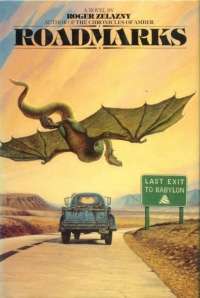Roadmarks
Roadmarks is a science fantasy novel by American author Roger Zelazny, written during the late 1970s and published in 1979.
 Cover of first edition (Hardcover) | |
| Author | Roger Zelazny |
|---|---|
| Cover artist | Darrell K. Sweet |
| Country | United States |
| Language | English |
| Genre | Science fantasy |
| Publisher | Del Rey |
Publication date | October 1979 |
| Media type | Print (hardback & paperback) |
| Pages | 185 |
| ISBN | 0-345-28530-1 |
| OCLC | 4908136 |
| 813/.5/4 | |
| LC Class | PZ4.Z456 Rm PS3576.E43 |
The novel postulates a road that travels through time, with a nexus placed every few years where a handful of specially gifted people are able to get on and off. While there is a plot involving a series of assassination attempts on the protagonist, the novel's main strengths lie in the unique nature of the setting, character development, structure and the short vignettes on each of the would-be assassins.
The book has two poetry collections as characters. Les Fleurs du Mal by Charles Baudelaire and Leaves of Grass by Walt Whitman appear as cybernetic extensions of themselves. They are companions of the protagonist and his son Randy, and are referred to as "Flowers" and "Leaves" respectively. Both talk, argue and quote their own content frequently, exhibiting human-like intelligence to such degree that it seems certain they could easily pass the Turing test.
The novel alternates between non-linear "Two" and linear "One" chapters. Zelazny explained, "I did not decide until I was well into the book that since there was really two time-situations being dealt with (on-Road and off-Road—with off-Road being anywhen in history), I needed only two chapter headings, One and Two, to let the reader know where we are. And since the Twos were non-linear, anyway, I clipped each Two chapter into a discrete packet, stacked them and then shuffled them before reinserting them between the Ones. It shouldn't have made any difference, though I wouldn’t have had the guts to try doing that without my experience with my other experimental books and the faith it had given me in the feelings I’d developed toward narrative."[1] The book's editor was confused by the "Two" chapters and required Zelazny to rearrange the order of a few of them before publication.[1]
Plot summary
The central theme of the novel is time travel using a highway that links all times and all possible histories.[2] Exits from the highway lead to different times and places. Changing events in the past cause some exits further up the road, in the future, to become overgrown and inaccessible and new exits to appear, leading to different alternative futures.
The narrator and protagonist, Red Dorakeen, has vague memories of a place or time that is no longer accessible from the Road. He runs guns to the Greeks at Marathon, trying to recreate history as he remembers it in an attempt to open a new exit from the Road to his half-remembered place. The phrase "Last Exit to Babylon" was the manuscript title of the book and appears on the cover art; it was later used as a title for Volume Four in the Collected Stories of Roger Zelazny collection.[3]
All "One" chapters feature Red Dorakeen, and all "Two" chapters feature secondary characters. These are Red's natural son Randy, newly introduced to the Road and tired of his old life in Ohio; a bevy of would-be assassins attempting to kill Red, some of whom are comic references to pulp characters, or real people (it is implied that Ambrose Bierce is writing a novel somewhere on the metaphysical highway) and Leila, a woman whose fate is bound to Red's in mysterious and unexplained ways.
The "One" storyline is fairly linear, but the "Two" storyline jumps around in time and sequence, first bringing in Randy and Leila without introduction, then later showing Randy's introduction to the Road and meeting with Leila, who will/has just abandoned Red following an incident in the "One" timeline. Everything comes clear in the final chapter, however.
There are a number of interesting humorous touches and allusions in the story. These include an ancient dragon who falls in love with a tyrannosaurus, a futuristic warrior robot left behind by aliens because it is malfunctioning and has now taken up pottery, a lost crusader who now works in a gas station located somewhere on the timeless road, occasionally asking his customers about the "current" status of the Holy Land, an ancient Sumerian who buries artifacts later to be found by himself as archaeologist, along with the brief appearances of pulp heroes such as Doc Savage and John Sunlight as well as real historical figures, including Jack the Ripper, Marquis de Sade and an angry Adolf Hitler (who is furiously searching for the place "where he won").
Reception
Greg Costikyan reviewed Roadmarks in Ares Magazine #5 and commented that "Roadmarks is a fun book – and, from anyone but Zelazny, it would be considered a tour de force. Its major difficulty would seem to be that Zelazny tried to force too many ideas into a length unsuited for them, this being unable to exploit all of those ideas to satisfying fullness."[4]
References
- "...And Call Me Roger": The Literary Life of Roger Zelazny, Part 4, by Christopher S. Kovacs. In: The Collected Stories of Roger Zelazny, Volume 4: Last Exit to Babylon, NESFA Press, 2009.
- Primeau, Ronald (1996). Romance of the Road The Literature of the American Highway. Bowling Green, Ohio: Bowling Green State University Popular Press. pp. 97–98. ISBN 978-0-87972-698-0.
- http://www.nesfa.org/press/Books/Zelazny-4.html
- Costikyan, Greg (November 1980). "Books". Ares Magazine. Simulations Publications, Inc. (5): 10.
- Levack, Daniel J. H. (1983). Amber Dreams: A Roger Zelazny Bibliography. San Francisco: Underwood/Miller. pp. 59–60. ISBN 0-934438-39-0.